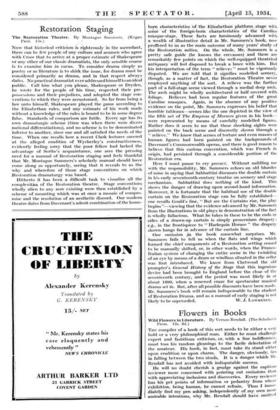Restoration Staging
. . -
ow that historical criticism is righteously in the ascendant, there can be few people of any culture and acumen who agree with Croce that to arrive at a proper estimate of Shakespeare or any other of our classic dramatists, the only sensible course is to examine him in vacuo. To consider drama simply as poetry or as literature is to shirk the issue, for drama must be considered primarily as drama, and in that respect always dales. No practical dramatist ever addressed himself to an ideal public. Call him what you please, Shakespeare or Dryden, he wrote for the people of his time, respected their pre- possessions and their prejudices, and adopted the stage con- ventions to which they were accustomed. So far from being a law unto himself, Shakespeare played the game according to the Elizabethan rules, and any estimate of his work made .without a knowledge of the rules is bound to be in some degree false. Standards of comparison are futile. Every age has its own dramaturgic scheme (time was when there were divers national differentiations), and no scheme is to be denominated inferior to another, since one and all satisfied the needs of the time. When one recalls how a recent Clark lecturer sneered at the alleged crudities of Wycherley's constructiveness, evidently feeling sorry that the poor fellow had lacked the advantage of Scribe's acquaintance, one sees the pressing need for a manual of Restoration staging and feels thankful that Mr. Montague Summers's scholarly manual should have come along so opportunely, seeing that it reveals to us the why and wherefore of those stage conventions on which Restoration dramaturgy was based.
Hitherto it has been a difficult task to visualize all the complexities of the Restoration theatre. Stage conventions wholly alien to any now existing were then established by a scheme of mounting which was at once a mosaic of compro- mise and the resolution of an aesthetic discord. Our modern theatre dates from Davenant's adroit combination of the home- born characteristics "of the .Elizabethan platform stage with some of the foreign-born characteristics of the Caroline masque-stage. These facts are luminously advanced with a wealth of illustrative detail in Mr. Summers's book, now proffered to us as the main outcome of many years' study of
the Restoration milieu. On the whole, Mr. Summers is a
pretty safe guide (he knows the crevasses) and there are remarkably few points on which the well-equipped theatrical antiquary will feel disposed to break a lance with him. BUt his interpretation of the term " relieve3 " must be vigorously disputed. We are told that it signifies modelled scenery, though, as a matter of fact, the Restoration Theatre never employed anything of the sort. A relieve was the further part of a full-stage scene viewed through a medial deep arch.
The arch might be wholly architectural or half covered with foliage. Relieves had been regular features of the great Caroline masques. Again, in the absence of any positive evidence on the point, Mr. Summers expresses his belief that
horrible tableaux—scenes like the one depicted in the view of the fifth act of The Empress of Morocco given in his book—
were represented by means of carefully modelled figures.
Rather does it seem to me that these shocking sights were painted on the back scene and discreetly shown through a relieve." We know that scenes of torture and even masses of human figures had been painted on the backgrounds of Davenant's Commonwealth operas, and there is good reason to believe that this curious convention, which was French in origin, had persisted through a considerable portion of the Restoration era.
Here I must pause to cry peccavi. Without saddling me with the responsibility, Mr. Summers echoes an old blunder
of mine in saying that Sabbattini discusses the double curtain in his early seventeenth-century treatise on scenery and stage mechanism. Sabbattini does nothing of the kind. This shows the danger of drawing upon second-hand information.
Moreover, it is fortunate that the habitual use of the double curtain on the Restoration stage can be fully established—
one recalls Gould's line, "But see the Curtains rise, the play begins "—viewing that the evidence advanced by Mr. Summers from the illustrations in old plays in demonstration of the fact
is wholly fallacious. What he takes in these to be the ends Or sides of a drawn-up curtain is simply proscenium drapery : e.g., in the frontispiece to "Harlequin Horace" the drapery shown hangs far in advance of the curtain line.
One omission ;in the book somewhat surprises. Mr. Summers fails to fell us when the flats and wings which
formed the chief components of a Restoration setting ceased to be manually shifted, or, in other words, when the Franco- Italian system of changing the entire scene in the twinkling
of an eye by means of a drum or windlass situated in the cellar was first introduced. We know from Chetwood the old prompter's General History of the Stage that this ingenious
device had been brought to England before the close of the seventeenth century, and the period was most likely in or about 1690, when a renewed craze for spectacular musical drama set in. But, after all possible discounts have been made. Mr. Summers's book will remain indispensable to the student of Restoration Drama, and as a manual of early staging is not
















































 Previous page
Previous page